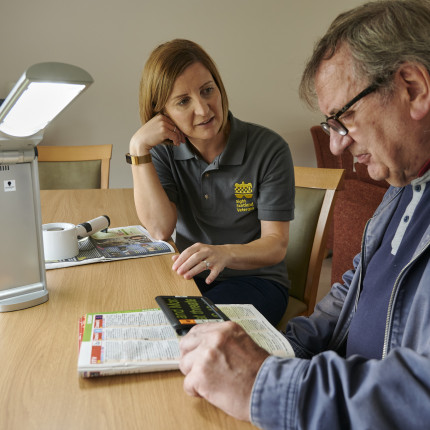For people with sight loss, good lighting can make many everyday tasks such as reading and moving around safely much easier to carry out.
As we age, we require more light to carry out everyday tasks. We may find ourselves moving towards a window for natural light or under a lamp when trying to read small print. But the need for more light increases dramatically for visually impaired people, who require up to five times more light. Simple, inexpensive changes to lighting and the way it is used can make a big difference for a visually impaired person in their everyday life.
Here you’ll find some helpful tips and advice on good lighting for people with sight loss from our rehabilitation experts:
Managing glare
Many visually impaired people suffer from glare, which is caused by bright light sources. Glare can cause severe discomfort and make it very difficult to focus, reducing remaining vision and contrast. At times, glare may be so intense that vision is completely impaired.
Glare sources include windows, glossy magazine pages or incorrectly designed and installed artificial lighting.
Indirect glare can result from reflections coming off polished or glossy surfaces such as flooring, shiny tables or kitchen work surfaces.
Lighting which contributes towards glare should be avoided. Direct daylight into the eyes can also cause glare.
- In order to have better control of natural light and glare in your home, windows can be fitted with curtains or blinds.
- White, sphere-shaped paper shades are recommended to provide good, even lighting. The sphere shape prevents a direct view of the bulb, helping to control glare, and maximising the light throughout the room.
- Task lighting should be directed on to the task at hand such as over a book or kitchen work top and not directed into the face.
- Anti-glare shields can be worn inside when suffering from discomfort glare.
Maximise use of natural daylight
Natural daylight is the best source of light. To maximise this use of natural light in the home, ensure windows are cleaned regularly inside and out.
Remove any clutter around windows and avoid using net curtains, as these can stop natural light getting through.
It should be noted that for some individuals with, for example glaucoma, bright light can be uncomfortable and as such light should be controlled and adjustable, such as having window blinds to open and close as needed.
Many visually impaired people’s lighting needs may vary from day to day and lighting levels may need to be adjustable. Dimmer switches can be installed to allow the light level to be adjusted.
Brightness levels in the home
Good lighting should provide even illumination, avoiding shadows and dark areas in a room. This is particularly important for safety when moving around the home, minimising the risk of trips and falls. Take care to ensure good lighting is installed around staircases and steps, where the risk of falling is even greater.
Brightness levels should be similar throughout the home environment to ensure moving between well-lit and darker and poorly lit areas is avoided. This is because the eyes take time to adjust.
For many people with sight loss, lighting needs can also vary from day to day. Dimmer switches can be a great way to easily adjust lighting and brightness levels according to what’s needed.
Task lighting
Task lighting is any light that can be used to help carry out a specific task. It is especially helpful for close work such as reading, food preparation, hobbies such as arts and crafts, and at mealtimes to illuminate food on a plate.
In the bathroom, for example, some visually impaired people use task lighting for shaving or applying makeup.
Task lighting shines directly onto the working surface providing a concentrated light source. Many task lamps are adjustable and can be tabletop, portable or floor-standing.
Using task lighting can also help to prevent eye strain, enhance colour contrast and help with posture.
LED lighting
LED bulbs are a simple, inexpensive, and effective way to improve lighting for people with sight loss. They are sold by numerous retailers, both online and in stores.
- Remember to check if your light fitting is bayonet or screw fitting bulbs and, if you have dimmer switches, whether or not they are dimmer switch compatible. A good example is a 13W LED bulb which is the equivalent of the older 100W incandescent bulb, and is A+ energy efficient. It lasts up to 20,000 hours.
- An LED keyring light is a handy, compact and lightweight option for quick tasks; especially for helping to identify the front door keyhole.
